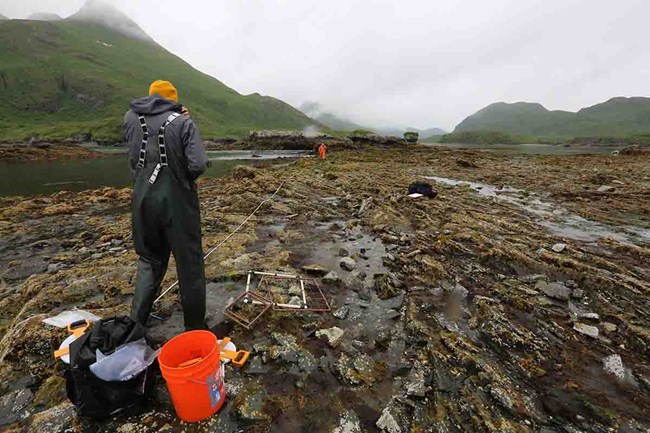Last updated: April 16, 2018
Article
Drivers of Change in Intertidal Communities

NPS/Jim Pfeiffenberger
The intertidal zone is an important source of primary production and a conduit for energy, nutrients, and pollutants between terrestrial and marine environments. It is particularly susceptible to human disturbance including oil spills; trampling by recreational visitors; harvesting activities; pollutants from terrestrial, airborne, and marine sources; and shoreline development.
These rocky intertidal communities are structured by local- and large-scale environmental drivers that can be dynamic (fluctuating over time, such as temperature and salinity) or static (not varying greatly across years, such as wave exposure and fetch/the distance wind travels over open water).
Understanding and managing nearshore community resilience (how it recovers from disturbance) requires knowledge about how static and dynamic drivers work together to influence community structure. In a recent study, we examined the role of six static drivers (distance to freshwater, tidewater glacial presence, wave exposure, fetch, beach slope, and substrate composition) on intertidal community structure across six regions in the northern Gulf of Alaska (see map). We found that these static drivers had little influence on the structure of the communities. We attribute this lack of influence as a possible result of our site selection, which targeted sheltered rocky communities across the Gulf.
In the future, greater frequency of environmental extremes is likely, including greater fluctuations in large-scale events such as the Pacific Decadal Oscillation or the recent warm Blob in the North Pacific. In high latitudes, dynamic drivers such as temperature change, increased glacial melt, and river discharge due to permafrost melting, sea-level rise, and increases in the frequency of storms will affect rocky shores and coastal environments. It is thought that over the next 25 years, rocky shore communities will change subtly and will be subject to increasing degradation.
Our continued work in these communities will help us assess and predict changes in coastal environments due to a host of natural and anthropogenic processes.
Influence of Static Habitat Attributes on Local and Regional Rocky Intertidal Community Structure
Abstract
Rocky intertidal communities are structured by local environmental drivers, which can be dynamic, fluctuating on various temporal scales, or static and not greatly varying across years. We examined the role of six static drivers (distance to freshwater, tidewater glacial presence, wave exposure, fetch, beach slope, and substrate composition) on intertidal community structure across the northern Gulf of Alaska. We hypothesized that community structure is less similar at the local scale compared with the regional scale, coinciding with static drivers being less similar on smaller than larger scales. We also hypothesized that static attributes mainly drive local biological community structure. For this, we surveyed five to six sites in each of the six regions in the mid and low intertidal strata. Across regions, static attributes were not consistently different and only small clusters of sites had similar attributes. Additionally, intertidal communities were less similar on the site compared with the region level. These results suggest that these biological communities are not strongly influenced by the local static attributes measured in this study. An alternative explanation is that static attributes among our regions are not different enough to influence the biological communities. This lack of evidence for a strong static driver may be a result of our site selection, which targeted rocky sheltered communities. This suggests that this habitat may be ideal to examine the influence of dynamic drivers. We recommend that future analyses of dynamic attributes may best be performed after analyses have demonstrated that sites do not differ in static attributes.
Konar, B., K. Iken, H. Coletti, D. Monson, and B. Weitzman. 2016. Influence of static habitat attributes on local and regional rocky intertidal community structure. Estuaries and Coasts 39: 1735-1745.
Detecting and inferring cause of change in an Alaska nearshore marine ecosystem
Abstract
Community composition, species abundance, and species distribution are expected to change while monitoring ecosystems over time, and effective management of natural resources requires understanding mechanisms contributing to change. Marine ecosystems in particular can be difficult to monitor, in part due to large, multidimensional spatial scales and complex dynamics. However, within the temperate marine ecosystems, the nearshore food web is reasonably well described. This food web is ecologically and socially important, spatially constrained, and has been the focus of extensive experimental research that describes the underlying mechanisms important to system dynamics. Here, we describe a monitoring program initiated in 2006 that focuses on the nearshore benthic food web in the Gulf of Alaska, whose design anticipates potential causes of ecosystem change to improve rigor, resolution, and confidence in understanding the mechanisms underlying change. We established 15 long‐term monitoring sites across more than 1000 km of coastline, including 10 within two national parks and 5 within Prince William Sound, area of the 1989 Exxon Valdez oil spill. The program evaluates six ecological indicators and more than 200 species that range from primary producers to top‐level consumers, and is designed to examine both bottom‐up and top‐down dynamics. Employing a design that allows broad spatial inference and selecting species with direct food‐web linkages, we demonstrate the ability of our monitoring program to simultaneously detect change and assess potential mechanisms underlying that change. Detecting change and understanding mechanisms can help guide management and conservation policy. Specifically, we provide an example focusing on the sea otter (Enhydra lutris) that illustrates how (1) analytical methods are used to evaluate changes on various scales and infer potential mechanisms of change, (2) food‐web linkages can enhance the understanding of changes and their effects, and (3) data can be used to inform management.
Coletti, H. A., J. L. Bodkin, D. H. Monson, B. E. Ballachey, and T. A. Dean. 2016. Detecting and inferring cause of change in an Alaska nearshore marine ecosystem. Ecosphere 7(10):e01489.
